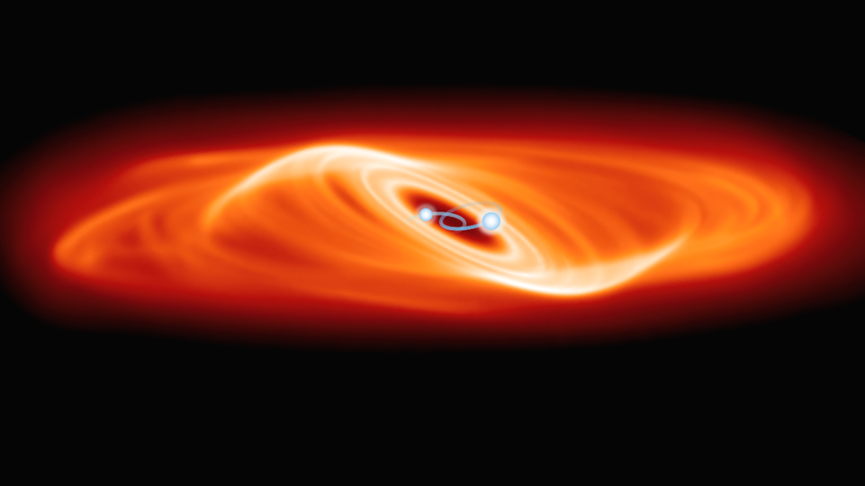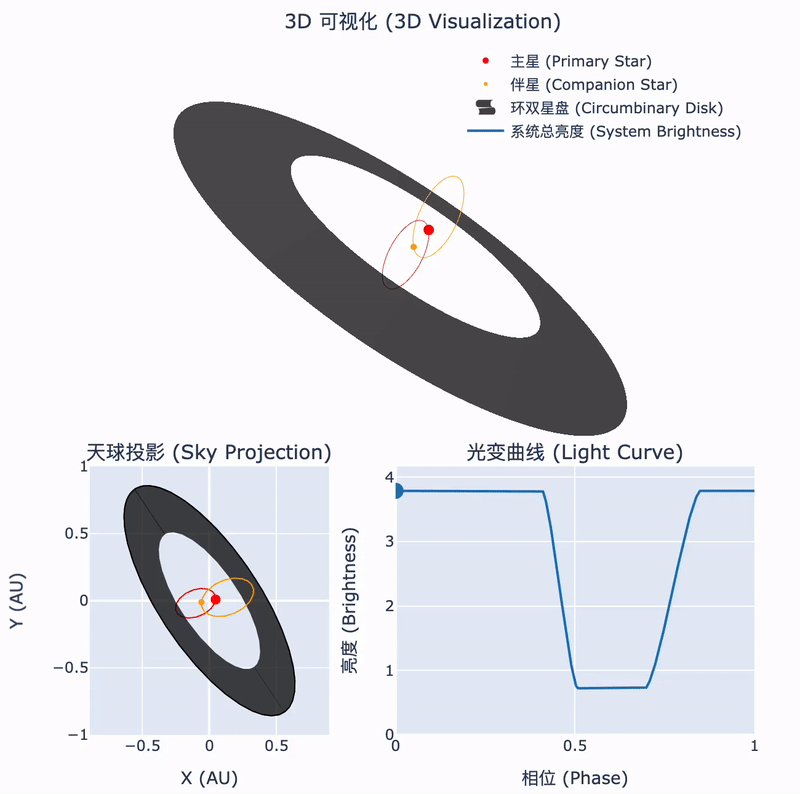During the collapse of a molecular cloud into stars, some of the remaining material forms a circumstellar disk. In binary systems, this disk may surround the orbits of both stars. The interactions between such a circumbinary disk and the central binary can lead to fascinating astrophysical phenomena. Recently, an international team led by Tsinghua astronomers has identified such a unique object: a binary system being occulted by a misaligned circumbinary disk. This is the second confirmed system of this category since the discovery of its prototype in 1998.

Artist's impression of a binary system with a warped circumbinary disk. The disk occults part of one star's orbit, causing significant dimming when the star passes behind it.
Image credit: Poon, Zhu, Zanazzi, University of Toronto; Sahl Rowther et al., Warwick University.
The newly confirmed system represents a rare class of binary systems. From certain viewing angles, the circumbinary disk occults portions of the binary orbit. In this system, the primary star's orbit (shown as the red trajectory in the video) is partially obscured by the disk. When the primary star passes behind the disk, its brightness drops dramatically due to the occultation, causing the system's total luminosity to undergo periodic variations by nearly an order of magnitude.

Schematic illustration of a binary system periodically occulted by its circumbinary disk. Such dramatic periodic brightness variations can only be observed when the system is viewed from specific angles relative to the observer.
In 2022, Associate Professor Wei Zhu from Tsinghua University, in collaboration with amateur astronomer Klaus Bernhard and other researchers, discovered two candidate systems of this special category through analysis of archival photometric data (see previous report). These candidates were designated as Bernhard-1 and Bernhard-2. However, the photometric observations available at that time were insufficient to confirm the presence of binary stars in these systems.
One effective method to verify the presence of a binary system is to measure changes in its radial velocity through spectroscopic observations. Due to gravitational interactions, stars in a binary system orbit around each other. When a star moves toward the observer, the wavelength of the electromagnetic waves it emitted decreases; conversely, when the star moves away, the wavelength increases—this phenomenon is known as the Doppler effect. By tracking variations in the wavelengths of spectral lines with time, researchers can reconstruct the stellar orbital motion and determine whether the star is part of a binary.
In the recent study, the team conducted spectroscopic observations of Bernhard-2 using several large telescopes, including the Gran Telescopio Canarias (GTC), Keck Telescope, and Magellan Telescope. Through detailed spectral analysis, the research team discovered significant periodic variations in the system's radial velocity. This finding supports the hypothesis that there is indeed a stellar binary in Bernhard-2. Consequently, a central binary periodically occulted by a misaligned circumbinary disk emerges as the best theoretical model to explain the system's distinctive photometric variations.
Further analysis of the observational data reveals that the system exhibits several intriguing dynamic phenomena, including the ongoing change in the angle between the circumbinary disk and the binary orbital plane, as well as evidence of periodic accretion onto the central binary. Continued observations of these dynamic processes will advance our understanding of the evolution and interaction mechanisms between binary stars and their circumbinary disks.
This study has been published in The Astrophysical Journal Letters. Tsinghua DoA graduate student Zhecheng Hu is the first author, and Associate Professor Wei Zhu is the corresponding author. Other coauthors are from the University of Hawaii, Weizmann Institute of Science, University of Chinese Academy of Sciences, Purple Mountain Observatory, as well as an amateur astronomer from Massachusetts, USA. The work of the Tsinghua team was supported by the National Natural Science Foundation of China.
Paper link:
https://doi.org/10.3847/2041-8213/ad94e8


